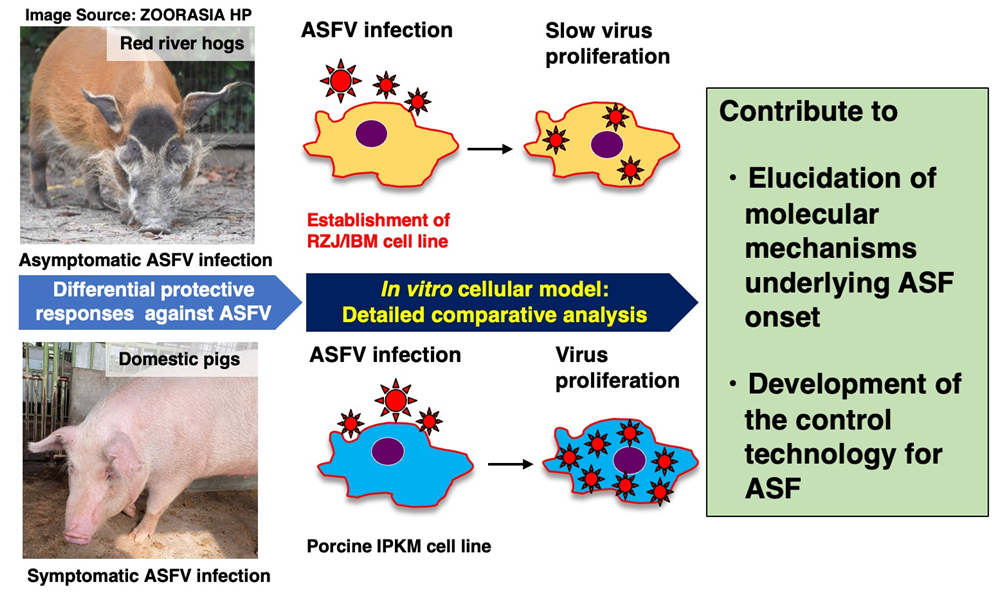African swine fever virus (ASFV) infection is a major global challenge faced by pig farming. However, ASFV infection in Red river hogs (RRHs) is typically asymptomatic which is said to be a distinctive feature. Hence National Agriculture and Food Research Organization (NARO), in collaboration with Yokohama Zoological Gardens ZOORASIA, isolated macrophages, a type of immune cells, from the blood of RRHs which are not infected by ASFV and established a cell line that continues to proliferate over a long period of time. This cell line can be used to elucidate the pathogenicity of ASFV, which remains shrouded in mystery. It is also expected to be useful in the development of African swine fever (ASF) vaccine.
Overview
Red river hogs (RRHs) (Potamochoerus porcus), a wild species living in Africa, have grabbed much attention as an animal that harbors African swine fever virus (ASFV) as natural hosts. When ASFV infects domestic pigs and wild boars, it proliferates within macrophages, a type of immune cells, and infected pigs rapidly die suffering from symptoms such as fever and hemorrhage. On the other hand, ASFV infection in RRHs is asymptomatic and does not cause death, suggesting that RRH macrophages may have a protective mechanism against ASFV infection.
Generally, in vitro cell cultures of porcine macrophages are used in ASFV research. However, inducing macrophage proliferation in vitro was challenging. NARO developed the first immortalized porcine kidney macrophage cell line, IPKM, that has an almost unlimited proliferation capacity in vitro. The use of the IPKM cell line has improved the efficiency of research material collection and significantly advanced ASFV research.
To further advance ASFV research, NARO collaborated with Yokohama Zoological Gardens ZOORASIA and received precious surplus blood collected during the routine health check of RRHs which are not infected by ASFV. NARO has succeeded in isolating macrophages from the blood and established a novel macrophage cell line (RZJ/IBM cell line) with the ability to proliferate continuously outside the body. It was also demonstrated experimentally that ASFV proliferation was far less vigorous in RZJ/IBM cell cultures compared with IPKM cell cultures. It is expected that detailed comparative analysis of the differential responses between these two cell lines will bring us closer to the mystery behind the asymptomatic nature of ASFV-infected RRHs. This elucidation is expected to pave way for the prevention of ASF and the development of an ASF vaccine (Fig. 1).

Fig. 1 Prospects for African swine fever virus (ASFV) research using
Red river hog macrophage-derived cell lines
Budget
Regulatory research projects for food safety, animal health and plant protection
(JPJ008617. 20319736) funded by the Ministry of Agriculture, Forestry and Fisheries of Japan.
Publication
Takato Takenouchi, Kentaro Masujin, Rina Ikeda, Seiki Haraguchi, Shunichi Suzuki, Hirohide Uenishi, Eiji Onda, and Takehiro Kokuho. (2024) Front. Immunol. 15:1465952. DOI: 10.3389/fimmu.2024.1465952 published on 2024/09/11
For Inquiries
Contact: https://www.naro.go.jp/english/inquiry/index.html




